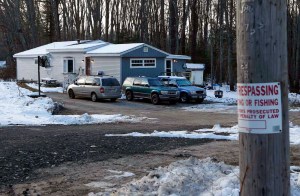At least 760 children died of abuse or neglect in the U.S. in a six-year span in plain view of child protection authorities — many of them beaten, starved or left alone to drown while agencies had good reason to know they were in danger, The Associated Press has found.
To determine that number, the AP canvassed the 50 states, the District of Columbia and all branches of the military — circumventing a system that does a terrible job of accounting for child deaths. Many states struggled to provide numbers. Secrecy often prevailed.
Most of the 760 children whose cases were compiled by the AP were under the age of 4. They lost their lives even as authorities were investigating their families or providing some form of protective services because of previous instances of neglect, violence or other troubles in the home.
Failure at its extreme
The case of 10-week-old Ethan Henderson — whose family in Arundel, Maine, had been the subject of at least 13 calls to child protective services or police — presents a particularly telling example of a repeated systemic failure.
Only two of those calls were investigated — one involving Ethan and his twin brother, and the other, their sister. In addition, more than a half-dozen physicians, nurses and other caregivers failed to report signs that the blue-eyed boy with wispy blond hair was being terribly hurt. Some have escaped scrutiny and punishment to this day.
Maine child welfare officials said the state’s confidentiality law prohibited them from discussing details about their involvement in Ethan’s case. Records obtained by AP, however, suggest the state missed numerous opportunities to properly assess the safety of Ethan and his siblings, neglecting to follow up promptly even after identifying warning signs.
According to evidence produced as part of the criminal case against Ethan’s father, Gordon Collins-Faunce, the police made two of those calls but hotline workers decided that neither merited a response.
Ethan’s grandmother, Jan Collins, said she called the hotline just before the twins were born because she feared her son and another man who frequented the family’s mobile home could hurt the children.
“I said I thought Gordon was delusional. They just dismissed that,” she said. “I kept thinking that tomorrow I will find out that the state has gotten involved.”
The twins were born a few weeks premature on Feb. 21, 2012 — and just four weeks later, Ethan’s mother took him to a nearby hospital with a broken left arm. She told his pediatrician that Ethan’s father had accidentally twisted it lifting the baby from his crib. The doctor never reported the injury, even though Maine law requires physicians to immediately report possible child abuse.
About a month later, Ethan arrived at day care unable to move his neck and with dark bruises on his right arm. Workers took photos of the bruises, but never reported them, said Maine Police Detective Lauren Edstrom, who investigated Ethan’s death. The next week, Ethan arrived at daycare with such a high fever that workers called his mother to take him to the hospital, evidence shows.
When Ethan was nearly 10 weeks old, a family friend finally called the hotline to report bruises on the twins and a white, blistering burn on their sister’s hand. Edstrom said the friend decided to tell hotline workers she was a daycare volunteer so that they would take the report seriously. That represented the second report worthy of investigation.
Melissa Guillerault, the child welfare agency worker dispatched to the gray double-wide trailer on May 2, called ahead to let the family know she was coming. Still, she found Collins-Faunce and his wife had five bags of trash on the porch.
Though the state later acknowledged Guillerault learned of Ethan’s earlier broken arm during that visit, records show she found the couple to be “cooperative and engaging.” She said the children “appeared clean, healthy and comfortable,” although she didn’t inspect them for bruises. In a section of her report designated for the listing of “signs of danger,” the worker wrote: “None at this time.”
Three days later, according to Collins-Faunce’s confession to police, he grew so frustrated by Ethan’s cries that he picked up his son by the head and threw him into a chair, causing severe brain damage. Before calling 911, evidence shows he went outside to smoke and play the video game “Police Pursuit.”
Ethan died three days later, on May 8, 2012. His father was convicted of manslaughter last year; his siblings were placed in foster care and adopted.
Virginia McNamara, a pediatric nurse who visited Ethan at his home and never reported the signs of possible abuse, lost her license to practice in Maine. Ethan’s pediatrician, Dr. Lisa Gouldsbrough, was never disciplined, although she received a letter of guidance from the Maine board that licenses osteopathic doctors aimed at helping her “in avoiding complaints of this nature in the future.” Guillerault was promoted to a supervisory role within the department, a position she still holds.
None of them responded to AP’s requests for comment, and neither did the Maine Department of Health and Human Services.
The records that spell out the state’s involvement with the family remain secret.
Lack of government data
Because no single, complete set of data exists for the deaths of children who already were being overseen by child welfare caseworkers, the information compiled over the course of AP’s eight-month investigation represents the most comprehensive statistics publicly available.
The AP reviewed thousands of pages of official reports, child fatality records and police documents for the period in question, which ran from fiscal year 2008 through 2013.
And, even then, the number of abuse and neglect fatalities where a prior open case existed at the time of death is undoubtedly much higher than the tally of 760.
Eight states reported a total of 260 open-case child deaths over the six-year period, but those were not included in the AP count because the states could not make a distinction between investigations started due to the incident that ultimately led to a child’s death and cases that already were open when the child received the fatal injury.
Some states did not provide data for all six years, not all branches of the military provided complete information, and no count of open-case deaths of any type was obtained from the Bureau of Indian Affairs or FBI, which investigate allegations of abuse on reservations.
The lack of comprehensive data makes it difficult to measure how well those responsible for keeping children safe are protecting their most vulnerable charges.
The data collection system on child deaths is so flawed that no one can even say with accuracy how many children overall die from abuse or neglect every year. The federal government estimates an average of about 1,650 deaths annually in recent years; many believe the actual number is twice as high.
Even more lacking is comprehensive, publicly available data about the number of children dying while the subject of an open case or while receiving assistance from the agencies that exist to keep them safe — the focus of AP’s reporting.
When asked to explain why so many children with open cases have died at the hands of their caretakers, a spokeswoman for the U.S. Department of Health and Human Services, which oversees the nation’s major child abuse prevention programs, said the agency had no immediate response.
But spokeswoman Laura Goulding said colleagues wanted to know more about how the AP derived its figures. “Are you willing to share your source for that?” she wrote in an email.
States submit information on child abuse deaths to the federal government on a voluntary basis — some of it comprehensive, some of it inaccurate.
A system still failing
When President Richard Nixon signed the Child Abuse Prevention and Treatment Act into law in 1974, it was seen as a sign of federal commitment to preventing child abuse through state-level monitoring.
But in 1995, a board reviewing the progress that had been made issued a scathing report headlined “A Nation’s Shame: Fatal Child Abuse and Neglect in the United States.”
The report called for better information and transparency, and flagged “serious gaps in data collection.” ”Until we develop more comprehensive and sophisticated data, our efforts to understand and prevent child maltreatment-related deaths will be severely handicapped,” it said.
Nearly 20 years later, the AP found that many such problems persist.
Michael Petit, who was appointed by President Barack Obama to serve on the federal Commission to Eliminate Child Abuse and Neglect Fatalities, said meetings have been fruitful but will bring no substantive change unless Congress requires states to do more.
“The child safety net in this country is not equal to the size of the problem that’s coming at it,” said Petit, the former head of Maine’s child protective services agency and founder of the advocacy group Every Child Matters. “The system overall is in crisis.”
That system is plagued with worker shortages and a serious overload of cases. For instance, a caseworker in Texas who investigated abuse reports about a 2-year-old who eventually died in the care of his mother was juggling 37 cases a few weeks before he died.
In addition:
* Budgets are tight, and some experts say funding shortages lead to more deaths. Conditions improved when Alabama spent more money on child welfare as part of a 15-year federal consent decree. But since 2007, when the decree ended, funding has shrunk nearly every year — and the number of open-case deaths has started to climb, from one in 2009 to five in 2013.
* Insufficient training for those who answer child abuse hotlines leads to reports being misclassified, sometimes with deadly consequences. In Arizona, a June 2013 call about an 8-month-old with a suspicious broken arm was logged incorrectly and not investigated. The girl died of a brain injury about a month later, after being burned on the face with a cigarette lighter and shaken violently.
* The lack of a comprehensive national child welfare database that would allow caseworkers to keep track of individual cases, child by child, means some abusive caregivers known to authorities can slip through the cracks by crossing state lines.
* A policy that promotes keeping families intact plays a major role in the number of deaths, because children remain in abusive situations. According to Vermont police, 2-year-old Dezirae Sheldon was left in her home even after suffering two broken legs under suspicious circumstances. Caseworkers said they’d felt “an overwhelming push” to keep the family together, based on their general training. Dezirae died in February from blunt force trauma to the head; her stepfather is charged with second-degree murder. A police detective wrote: “This focus on reunification very often puts the needs of the parents often above the needs and interest of the child or victim.”
* Worst of all, nearly 40 percent of the 3 million child abuse and neglect complaints made annually to child protective services hotlines in the U.S. are “screened out” and never investigated.









Comments are no longer available on this story